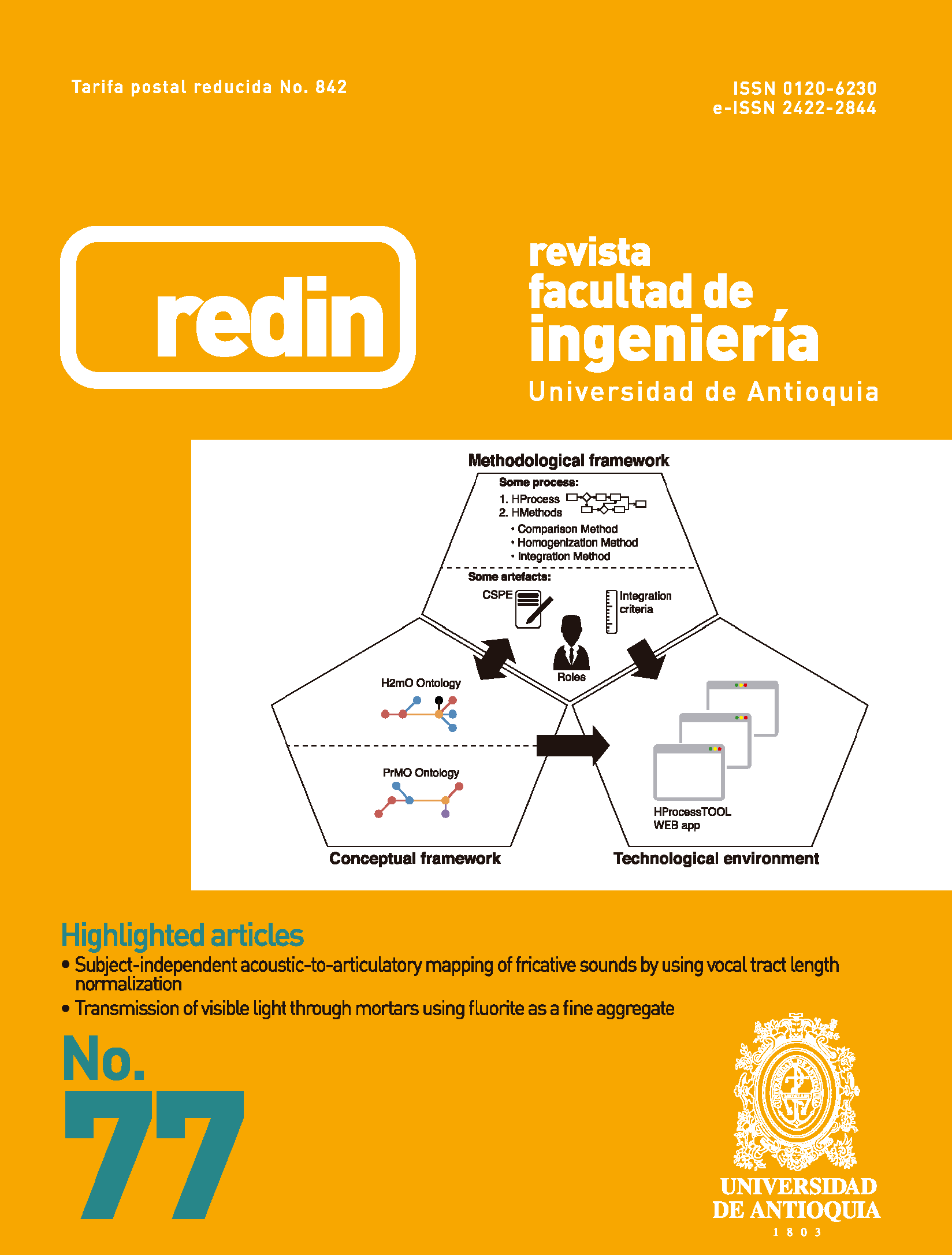Virtual test bench as a complement to study thermal area: application in vapor compression systems
DOI:
https://doi.org/10.17533/udea.redin.n77a08Keywords:
simulator, refrigeration, engineering students, learning, educationAbstract
This paper describes an educational simulator developed in the software Engineering Equation Solver to simulate the behavior of a vapor compression system. The application is focused on educational purposes, specifi cally for handling skills in refrigeration facilities by students in engineering careers. Using this simulator, the students are able to analyze easily the infl uence of the measured parameters (such as the compressor rotation speed, volumetric fl ow rates and temperature of the secondary fl uids) on the energy performance of the facility and its components. The virtual test bench consists of a primary screen showing a general scheme of the vapor compression facility with input and output parameters. From this primary screen, the performance of the main components can be analyzed. Finally, this virtual test bench was tested by engineering students, concluding that the simulator is an interesting tool as improvement and support for learning in different subjects.
Downloads
References
E. Smirnov and V. Bogun, “Information and communication technology in science learning as a tool for ‘scientific thinking’ in engineering education”, Natural Science, vol. 2, no. 12, pp. 1400-1406, 2010.
P. Axaopoulos and G. Pitsilis, “Energy software programs for educational use”, Renewable energy, vol. 32, no. 6, pp. 1045-1058, 2007.
J. Jiménez, J. Ramírez and J. González, “Collaborative robotics modular system used in education”, Rev. Fac. Ing. Univ. Antioquia, no. 58, pp. 163-172, 2011.
D. Mendes, C. Marangoni, A. Meneguelo, R. Machado and A. Bolzan, “Educational simulator for multicomponent distillation research and teaching in chemical engineering”, Comput. Appl. Eng. Educ., vol. 18, no. 1, pp. 175-182, 2010.
A. Rivas, T. Gómez and J. Ramos, “The application of spreadsheets to the analysis and optimization of systems and processes in teaching of hydraulic and thermal engineering”, Comput. Appl. Eng. Educ., vol. 14, pp. 256-268, 2006.
A. Lopes, “A versatile software tool for the numerical simulation of fluid flow and heat transfer in simple geometries”, Comput. Appl. Eng. Educ., vol. 18, no. 1, pp. 14-27, 2010.
K. Forbus et al., “CyclePad: An articulate virtual laboratory for engineering thermodynamics”, Artificial Intelligence, vol. 114, no. 1-2, pp. 297-347, 1999.
F. Machuca and O. Urresta, “Educational software for the teaching of the dynamics and control of shell and tube heat exchangers”, Rev. Fac. Ing. Univ. Antioquia, no. 44, pp. 52-60, 2008.
A. Martín and Mato, “Hint: An educational software for heat exchanger network design with the pinch method”, Education for chemical engineers, vol. 3, no. 1, pp. 6-14, 2008.
S. Dormido, “Control learning: Present and future”, Annual Rev. Control, vol. 28, no. 1, pp. 115-136, 2004.
M. Dubey, S. Rajput, P. Nag and R. Misra, “Energy analysis of a coupled power-refrigeration cycle”, Proceedings of IMechE, Part A: Power and Energy, vol. 224, pp. 749-759, 2010.
L. Pérez, J. Ortiz and C. Pout, “A review on buildings energy consumption information”, Energy and Buildings, vol. 40, pp. 394-398, 2008.
S. Ledesma and J. Belman, “Application of artificial neural networks for generation of energetic maps of a variable speed compression system working with R1234yf”, Applied Thermal Engineering, vol. 69, no. 1-2, pp. 105-112, 2014.
B. Bolaji, S. Adejuyigbe and J. Olonila, “Performance simulation of vapour compression refrigeration systems using ozone-friendly hydro-fluorocarbon refrigerants”, Annals of Faculty Engineering Hunedoara-International Journal of Engineering, vol. 12, no. 3, pp. 177-182, 2014.
L. Genik, R. Davis and C. Somerton, “Vapor-compression refrigeration simulation and tutorial”, in American Society for Engineering Education (ASEE) Annual Conference, Montreal, Canada, 2000, pp. 6761-6770.
J. Sieres and J. Fernández, “Simulation of compression refrigeration systems”, Comput. Appl. Eng. Educ., vol. 14, pp. 188-197, 2006.
IPU, CoolPack. [Online]. Available: http://en.ipu.dk/Indhold/refrigeration-and-energy-technology/coolpack.aspx. Accessed on: Aug. 15, 2014.
J. Corberán, J. Gonzalvez, P. Montes and R. Blasco, “‘ART’ a computer code to assist the design of refrigeration and A/C equipment”, in 9th International Refrigeration and Air Conditioning Conference, West Lafayette, USA, 2002, pp. 347-354.
J. Brown, P. Domanski and E. Lemmon. “Cycle_D version 4.0: Theoretical vapor compression cycle design program”, in 3rd IIR Conference on Thermophysical Properties and Transfer Processes of Refrigerants, Boulder, USA, 2009, pp. 170-177.
R. Antón, H. Jonsson, J. Ramos, T. Gómez and A. Rivas, “Refrigerating cycle simulator: system modelling, educational implementation and assessment”, International Journal of Engineering Education, vol. 25, pp. 324-332, 2009.
I. Eames, T. Brown, J. Evans and G. Maidment, “Description and validation of a computer based refrigeration system simulator”, Computers and Electronics in Agriculture, vol. 85, pp. 53-63, 2012.
J. Mendoza, J. Belman, A. Gallegos, A. Mota and J.Navarro, “Computational tool for experimental refrigeration system analysis using spreadsheets”, Dyna, vol. 89, pp. 608-615, 2014.
J. Belman, J. Navarro, D. Ginestar and V. Milian, “Steady-state of a variable speed vapor compression system using R134a as working fluid”, International Journal of Energy Research, vol. 34, pp. 933-945, 2010
Downloads
Published
How to Cite
Issue
Section
License
Copyright (c) 2015 Revista Facultad de Ingeniería Universidad de Antioquia

This work is licensed under a Creative Commons Attribution-NonCommercial-ShareAlike 4.0 International License.
Revista Facultad de Ingeniería, Universidad de Antioquia is licensed under the Creative Commons Attribution BY-NC-SA 4.0 license. https://creativecommons.org/licenses/by-nc-sa/4.0/deed.en
You are free to:
Share — copy and redistribute the material in any medium or format
Adapt — remix, transform, and build upon the material
Under the following terms:
Attribution — You must give appropriate credit, provide a link to the license, and indicate if changes were made. You may do so in any reasonable manner, but not in any way that suggests the licensor endorses you or your use.
NonCommercial — You may not use the material for commercial purposes.
ShareAlike — If you remix, transform, or build upon the material, you must distribute your contributions under the same license as the original.
The material published in the journal can be distributed, copied and exhibited by third parties if the respective credits are given to the journal. No commercial benefit can be obtained and derivative works must be under the same license terms as the original work.










 Twitter
Twitter